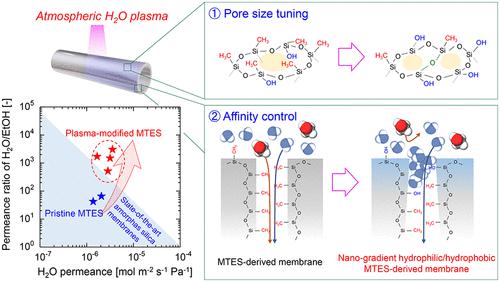Our official English website, www.x-mol.net, welcomes your feedback! (Note: you will need to create a separate account there.)
Nanogradient Hydrophilic/Hydrophobic Organosilica Membranes Developed by Atmospheric-Pressure Plasma to Enhance Pervaporation Performance
ACS Nano ( IF 17.1 ) Pub Date : 2022-06-21 , DOI: 10.1021/acsnano.1c11656 Shun Aoyama 1 , Hiroki Nagasawa 1 , Masakoto Kanezashi 1 , Toshinori Tsuru 1
ACS Nano ( IF 17.1 ) Pub Date : 2022-06-21 , DOI: 10.1021/acsnano.1c11656 Shun Aoyama 1 , Hiroki Nagasawa 1 , Masakoto Kanezashi 1 , Toshinori Tsuru 1
Affiliation

|
Organosilica membranes are a promising candidate for pervaporation dehydration owing to their tunable molecular sieving characteristics and excellent hydrothermal stability. Herein, we report a facile modification using an atmospheric-pressure water vapor plasma to enhance the pervaporation performance of organosilica membranes. The surface of methyl-terminated organosilica membranes was treated by water vapor plasma to develop an ultrathin separation active layer suitable for pervaporation dehydration. The surface hydrophilicity was increased by water vapor plasma due to oxidative decomposition of methyl groups to form silanol groups. The plasma-modified layer had a thickness of several nanometers and had a silica-like structure due to the condensation of silanol groups. The plasma-modified organosilica membranes exhibited an improved molecular sieving property owing to the formation of highly cross-linked siloxane networks with a pore size of approximately 0.4 nm. The membranes also exhibited an excellent permselectivity in the dehydration of alcohols due to the nanometer-thick separation active layer with controlled pore size and increased hydrophilicity. The plasma-modified membranes showed high H2O permeance exceeding 10–6 mol m–2 s–1 Pa–1 with permeance ratios for H2O/EtOH and H2O/IPA of 517–3050 and >10 000, respectively, in the dehydration of 90 wt % aqueous solutions at 50 °C, which is among the highest permselectivities for silica-based membranes. Furthermore, the plasma-modified membranes displayed highly efficient dehydration performance for a H2O/MeOH mixture. The H2O permeance and H2O/MeOH permeance ratio in the dehydration of a 90 wt % MeOH aqueous solution at 50 °C were (2.3–3.0) × 10–6 mol m–2 s–1 Pa–1 and 31–143, respectively, which exceeded the permeance-selectivity trade-off of conventional membranes including polymeric, silica-based, and zeolite membranes. The results indicate that the proposed plasma-assisted approach can enhance the pervaporation performance of organosilica membranes via the modification under atmospheric pressure and at room temperature.
中文翻译:

由大气压等离子体开发的纳米梯度亲水/疏水有机二氧化硅膜可提高渗透汽化性能
有机二氧化硅膜由于其可调的分子筛特性和优异的水热稳定性而成为渗透汽化脱水的有前途的候选者。在此,我们报告了一种使用大气压水蒸气等离子体进行的简便修改,以提高有机二氧化硅膜的渗透蒸发性能。水蒸气等离子体处理甲基封端的有机硅膜表面,形成适合渗透汽化脱水的超薄分离活性层。由于甲基氧化分解形成硅醇基,水蒸气等离子体增加了表面亲水性。由于硅醇基的缩合,等离子体改性层具有几纳米的厚度并且具有类二氧化硅结构。由于形成了孔径约为 0.4 nm 的高度交联的硅氧烷网络,等离子体改性的有机二氧化硅膜表现出改进的分子筛分性能。由于纳米厚的分离活性层具有可控的孔径和增加的亲水性,该膜在醇的脱水中也表现出优异的选择性渗透性。等离子体修饰的膜显示出高 H2 O 渗透率超过 10 –6 mol m –2 s –1 Pa –1,H 2 O/EtOH 和 H 2 O/IPA 的渗透率分别为 517–3050 和 >10 000,脱水率为 90 wt % 50 °C 的水溶液,这是二氧化硅基膜的最高选择性渗透率之一。此外,等离子体改性膜对 H 2 O/MeOH 混合物显示出高效的脱水性能。90 wt % MeOH水溶液在50 ℃脱水时的H 2 O渗透率和H 2 O/MeOH渗透率比为(2.3–3.0) × 10 –6 mol m –2 s –1Pa –1和 31–143,分别超过了传统膜(包括聚合物膜、二氧化硅基膜和沸石膜)的渗透选择性权衡。结果表明,所提出的等离子体辅助方法可以通过在大气压和室温下进行改性来提高有机二氧化硅膜的渗透汽化性能。
更新日期:2022-06-21
中文翻译:

由大气压等离子体开发的纳米梯度亲水/疏水有机二氧化硅膜可提高渗透汽化性能
有机二氧化硅膜由于其可调的分子筛特性和优异的水热稳定性而成为渗透汽化脱水的有前途的候选者。在此,我们报告了一种使用大气压水蒸气等离子体进行的简便修改,以提高有机二氧化硅膜的渗透蒸发性能。水蒸气等离子体处理甲基封端的有机硅膜表面,形成适合渗透汽化脱水的超薄分离活性层。由于甲基氧化分解形成硅醇基,水蒸气等离子体增加了表面亲水性。由于硅醇基的缩合,等离子体改性层具有几纳米的厚度并且具有类二氧化硅结构。由于形成了孔径约为 0.4 nm 的高度交联的硅氧烷网络,等离子体改性的有机二氧化硅膜表现出改进的分子筛分性能。由于纳米厚的分离活性层具有可控的孔径和增加的亲水性,该膜在醇的脱水中也表现出优异的选择性渗透性。等离子体修饰的膜显示出高 H2 O 渗透率超过 10 –6 mol m –2 s –1 Pa –1,H 2 O/EtOH 和 H 2 O/IPA 的渗透率分别为 517–3050 和 >10 000,脱水率为 90 wt % 50 °C 的水溶液,这是二氧化硅基膜的最高选择性渗透率之一。此外,等离子体改性膜对 H 2 O/MeOH 混合物显示出高效的脱水性能。90 wt % MeOH水溶液在50 ℃脱水时的H 2 O渗透率和H 2 O/MeOH渗透率比为(2.3–3.0) × 10 –6 mol m –2 s –1Pa –1和 31–143,分别超过了传统膜(包括聚合物膜、二氧化硅基膜和沸石膜)的渗透选择性权衡。结果表明,所提出的等离子体辅助方法可以通过在大气压和室温下进行改性来提高有机二氧化硅膜的渗透汽化性能。


























 京公网安备 11010802027423号
京公网安备 11010802027423号